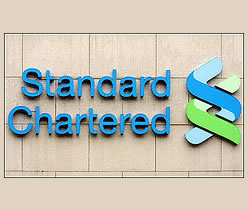
| StanChart says Vietnam economy on solid recovery track | |
Vietnam has weathered the global economic crisis relatively well with the assistance of proactive fiscal measures and resilient domestic demand, according to Standard Chartered Bank. The bank said in a report that along with other Asian nations like China, India, and Indonesia, Vietnam is one of the few countries that have not experienced a contraction in GDP. The country’s latest GDP growth data, for the third quarter of 2009, show that its economy is on a solid recovery track although the export sector remains sluggish, says the bank’s latest report on Vietnam’s economy. Tai Hui, StanChart regional head of research in South East Asia, said, “We have revised up our growth forecasts to 4.9% from 4.2% for 2009 to reflect this better-than-expected performance.” Vietnam’s GDP growth for 2010, the economist predicted, will be 6.7% instead of 5.0% as earlier forecast by the bank. For 2011, the rate has also been revised up to 7.2% from the previous 6.0%. The report, however, warns of new challenges that the country will be facing. The bank has revised its inflation forecasts modestly upward in line with the stronger growth projections. “We now expect the State Bank of Vietnam (SBV) to start hiking its base rate in the second quarter of 2010 instead of the third quarter, even though there are other tools available to the SBV to manage lending and contain inflationary pressure,” said Hui. The report notes that notwithstanding its more optimistic assessment of the Vietnamese economy, “risks are emerging that are not dissimilar to those encountered in 2008. In particular, the widening of the trade deficit in recent months points to an imbalance between domestic strength and external weakness.” Current inflation readings remain tame both on a year-on-year and a month-on-month basis, but aggressive fiscal and monetary stimulus is generating inflation expectations which could be self-fulfilling, said Hui, who has deep expertise in Vietnam’s economy. He pointed out that commodity prices could trigger a further deterioration in both the trade deficit and inflation, as he saw in 2008. In recent months, the authorities have resumed the Vietnamese dong’s 1% per annum depreciation against the U.S. dollar, a long-standing policy stance adopted between 2001 and 2007, he said. According to the report, given the deterioration in external balances, the bias will be for the Government to use the exchange rate more aggressively to narrow the trade deficit. Given Vietnam’s economic growth from its low of 3.1% in the first quarter of 2009 to 5.8% in quarter three, the recovery was largely driven by domestic demand, with retail sales growing consistently at around 20% between April and August 2009. As analyzed by the report, a rebound in industrial production has also added positive momentum to growth, even though export performance so far this year has been disappointing. However, despite bright signs of economic recovery, Hui is still concerned about whether Vietnam will face external payments stress and inflation again next year. Last year the country encountered the twin problems of a massive trade deficit and a surge in inflation, according to him. The trade deficit rose to US$18 billion last year, and inflation peaked at 28.3% year-on-year in August 2008. “We believe that these problems were caused by a combination of economic overheating and a sharp rise in commodity prices. Many are worried that 2010 could see a return of both problems. | |
| The Saigon Times Daily |
